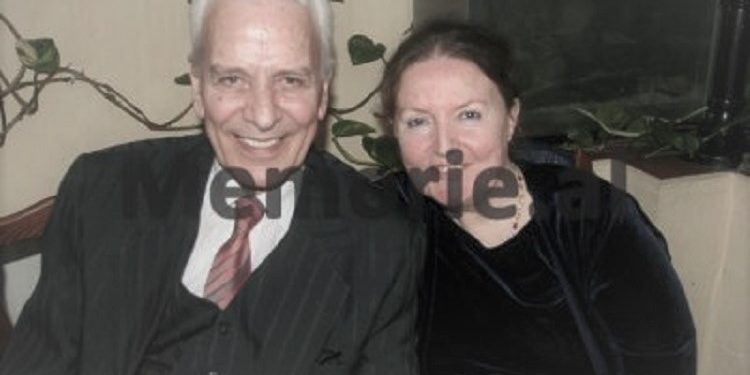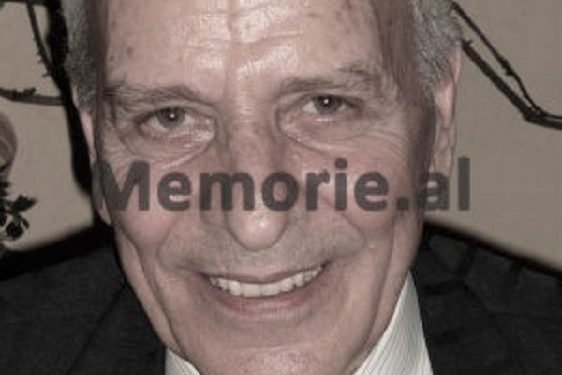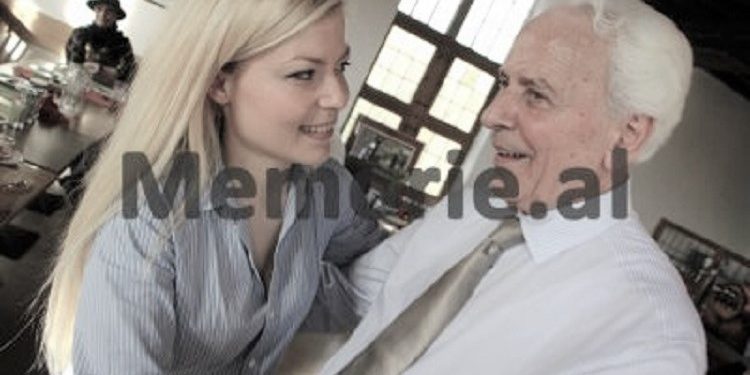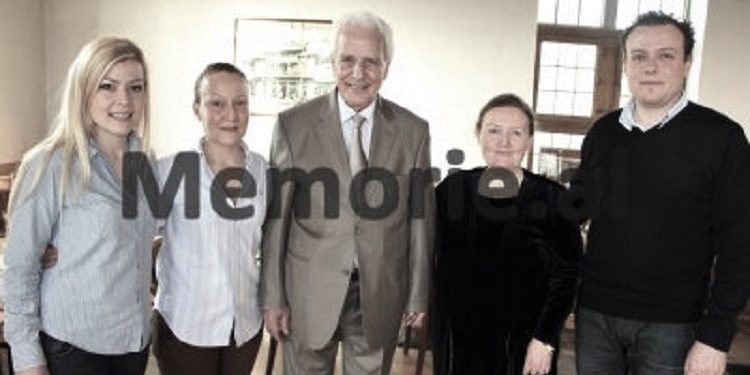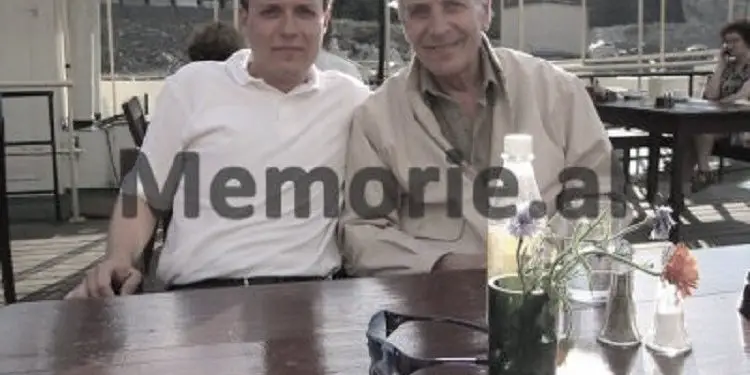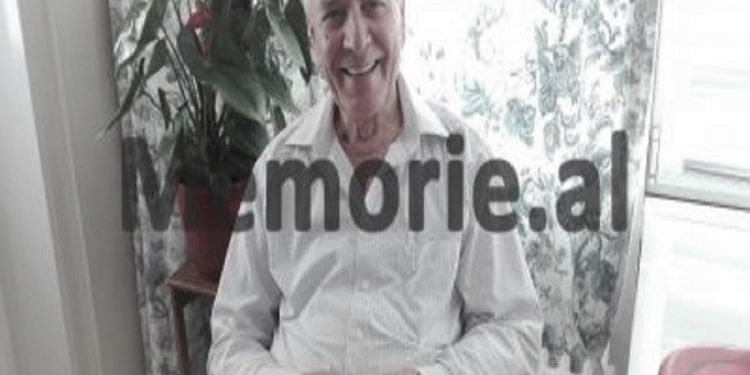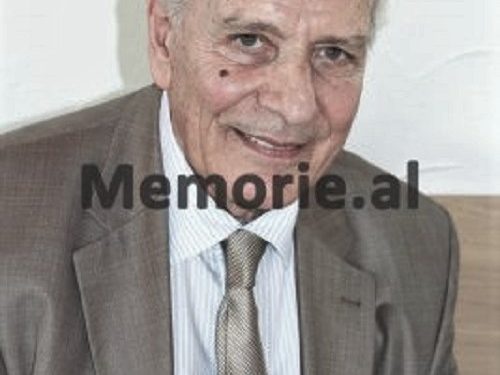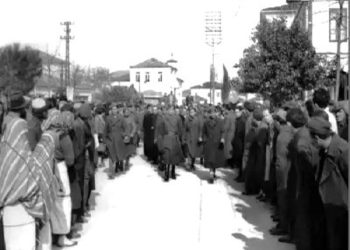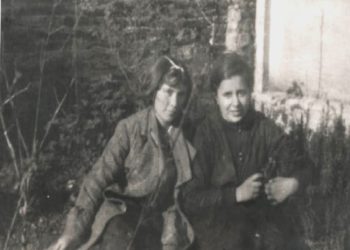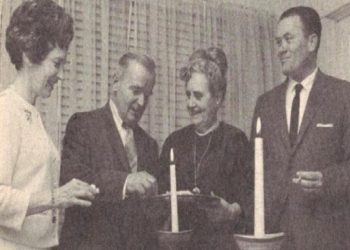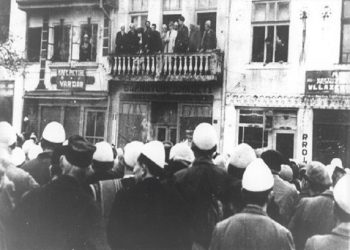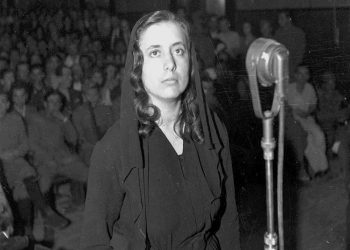Memorie.al/ publishes the unknown story of Myrteza Bajraktari, originally from Gostivar, who after graduating from high school in the city of Tetovo, in 1952 began higher studies at the University of Skopje in the branch of Philosophy, where in addition to teaching he was employed. as a journalist in the newspaper ‘Flaka e Vllaznimit’ published in Skopje, from where he was expelled soon after he published an article where he was openly against the displacement of Yugoslav Albanians to Turkey and as a result, he was appointed as a teacher in the 7-year school ‘Shaban Zeneli ‘of Kumanovo. Myrtezai was arrested by the UDB in 1952, after he was part of a secret organization called the ‘Albanian National-Democratic Organization’ and sentenced to seven years in political prison, which he served in the Nis and Idrizovo prisons… Escape from Yugoslavia and coming to Albania, where after staying for some time in the internment camp in Seman of Fier, he was given the right to high school by graduating from the University of Tirana in the branch of Language and Literature, but after refusing the appointment in the city of Berat, in 1971 he was arrested and sentenced to seven years in political prison, on charges of “agitation and propaganda”. Release from prison and unemployment until the fall of the communist regime and his appointment as Consul General of Albania in Switzerland until 1993, and then his election as Honorary President of the Albanian League in the World for the Benelux countries, where he worked on the issue of Kosovo until he passed away two days ago, on December 11, 2020.
Who was Myrteza Bajraktari?
Myrteza Bajraktari was born on April 15, 1933 in a patriotic family in Gostivar, Eastern Albania (as he rightly calls the Albanian areas of western Macedonia). He completed primary and 7-year school in his hometown, and high school in Tetovo and Skopje. In 1952 he enrolled at the University of Skopje in the branch of Philosophy, as a part-time student. In addition to his studies, he is employed in the newspaper “Flaka e Vllaznimit” which was published in Skopje. But in the meantime, he writes an article against the displacement of Albanians in Turkey and the opening of Turkish schools in the territories inhabited by Albanians, and for this reason they remove him from the newspaper as unwanted. He started working as a teacher in Kumanovo, in the 7-year school “Shaban Zeneli”. –
Meanwhile, in Skopje, together with some friends, he created the illegal organization SHKËNDIJA, at the core of whose program was the idea of Ethnic Albania, while its concrete activity focused on opposing the opening of Turkish schools and the forced expulsion of Albanians in Turkey. . This illegal group included about 20 students and teachers, distributed in seven triple cells. The trio was closed and had no connection and acquaintance with the other cells. The leader of all the groups was Kreshnik Pollogu (M. Bajraktari), who kept in touch with each group and directed their activity.
These groups operated in Gostivar, Prizren, Tetovo, Skopje, Zagreb, Debar and Struga. Myrteza’s counselor and spiritual leader was S. Lamçe. After several years of illegal activity, these groups disbanded. The first three were deconspired by Xhemal Pozharani during the investigation in July 1952. After three months, Luan Sadiku was arrested, while Myrteza Bajraktari was arrested on January 12, 1953. In the first session of the trial of Myrteza and Luan in the city of Skopje, the deconspirant Xhemal Pozharani is presented in military uniform.
In parentheses, it is known that the activity of Albanian nationalists in Kosovo and Macedonia has been extensive and uninterrupted. In addition to the illegal group SHKËNDIJA, there were other illegal communities, up to the largest group, the ALBANIAN NATIONAL-DEMOCRATIC ORGANIZATION, led by Azem Morana, who, after the discovery of this group, was shot along with other leaders. Most of them suffered in the Nis and Idrizovo prisons in Skopje. The manly attitudes of their members during the investigation and the courageous expression in the trials against them remain in the memory of the Albanians of those areas; It was written in the press and numerous government forces were engaged to find and convict them, which made a fuss and echoed in the Albanian public, being considered as an investment for the national cause, an investment that later bore fruit.
In order to create a broader picture of the circumstances in which Myrteza Bajraktari conducted her activity, it is necessary to provide indications regarding that environment. Thus, Preng Gruda in the book “As long as I have a soul, I have hope” (Euro Rilindja, Tirana 1997), in this regard, recalls: to the first …. In recent years, schools have been opened for them in Turkish and they forcibly force Albanians to take their children, just as they are forcibly expelling thousands of families from their votes and sending them to Turkey, where they await misery. of the desert plains of Anatolia.
The people and the teachers objected and demonstrated not to remove the children from the schools …. The first teachers imprisoned in Tetovo and Gostivar against the Turkish schools were: Myrteza Bajraktari, Murat Isaku, Myzafer Tufa etc. Before the trial, they stood manfully to defend the national cause. The prosecutor had demanded the death penalty … They did not wave at all and boldly replied: – We are happy to die for our homeland! – Serbs are shocked by the heroic attitude of these teachers during torture before the trial. The trial caused a stir in Yugoslavia and, especially, everywhere in Albanian districts, and thus the death penalty was suspended.
After the blow it received in Eastern Albania, the organization SHKËNDIJA, in order not to interrupt its activity, was temporarily forced to move its center to Zagreb, where it was already led by Naxhi Purde, one of the most excellent students at the University of Croatia. Over time, the organization’s activity intensified, especially to stop mass displacements to Turkey, using all possible, even impossible, means. As a result, this activity did not last long and was discovered in 1956, and as a result many of its members received severe punishments. Among the convicts was Mehdi Bajraktari (17 years old), Myrtezai’s younger brother, who, along with others, ended up in Idrizovo prison.
The character of this organization is clearly revealed in the formula of the oath that every new member was obliged to express with his hand placed on a revolver, the Quran and the Albanian flag: “I as an Albanian will always be ready to fight for the unification of all Albanians, especially those who are under the slavery of the Slavs, in a true Albanian; I will protect the interests of the Albanian people and I will consider the permanent fight against the traitors of the nation “. As stated in one of the chapters of the book by the author himself, the Macedonian author Dr. Tome Batkovski, Assistant Professor at the Faculty of Security and General Defense in Skopje, in his dissertation published in 1994: The Great Albanian Game in Macedonia, when he deals with: Illegal Communities – armed diversionist groups and illegal groups created by the position of Albanian nationalism in Macedonia in the period 1945-1987, also represents the nationalist anti-Macedonian activity of the organization SHKËNDIJA.
– Shkëndija was discovered and its initiator and chairman, Myrteza Bajraktari, was arrested on January 12, 1953, in front of the school of Kumanovo, where he had been a teacher for three months, before he was in his twenties. In the period January-October 1953, for nine months in a row, in the Serbo-Macedonian investigation in Skopje Castle, Myrtezai was subjected to inhuman tortures (up to broken bones, insomnia to loss of consciousness, stays in dungeons without light, with several centimeters of water , with three or four degrees of cement where you can stay in case you find hope for survival, blows with strong objects to the point of loss of consciousness; while pressures and psychological terror, savage cynicism, dirty swearing, etc. complemented the physical torture) .
Myrtezai himself states that “The mind loves that this castle, a symbol of resistance, was chosen not without purpose. “Their goal was to desecrate Albanian pride and break their resistance.” Myrtezain was physically mutilated, breaking his forearm. They left him untreated for four months in order to gangrene his arm. But the new organism did its job: the bone self-attached, but crooked, leaving it disabled for life. From 1953-1958, he served five years in prison in the infamous Idrizovo prison.
In 1960-1962 he was re-sentenced for another two years, which he suffered in Idrizovo. He testifies about his stoic stay in this prison in the military trial held in Tirana in 1970, where Myrtezaj and his accomplice Abdurrahman Haxhihalili were sentenced: “… In the Yugoslav prison of Idrizova, with over 3,000 prisoners – he declares, – “Myrtezai has been a symbol of resistance, which has kept all Albanian prisoner’s moral!” Other accomplices claim that Myrtezai was the instigator of the boycott by the prisoners and the unmasking of some prisoners who could not cope with the suffering and pressure of the prison administration and became their accomplices.
According to the testimonies of Bajraktar’s accomplices in Idrizovo, the group of 40 “dangerous” prisoners who had been isolated on the fifth floor of the prison became a legend there. This group, in addition to Albanians, also included members of the Macedonian organization VMRO, who were against the ruling regime. This group was not allowed to meet with other prisoners. They were only allowed to take a walk in the yard of the 5th prison called “mrtva setnja” (dead walk) with their hands behind their backs and their heads down. If any of the other prisoners, while entering and exiting the yard, directed their eyes or greeted the “dangerous”, they were sentenced to 14 days in prison. This group was only allowed one meeting with relatives for five minutes, once a month.
The young man from Gostivar, Myrteza Bajraktari, was also part of this group of “dangerous people”. When talking about those years of savage imprisonment, Myrtezai himself recalls a turning point in his own worldview. While previously he was influenced by the religious faith of his parents, but also the atheism of his older brother (Jamal), the difficult life of investigators and imprisonment for years, was accompanied by worldview changes, with significant turns in the spirit world. and in obedience. “Consequently,” he says, “without finding another way out, I began to pray to God to give me strength and clarity of thought, only not to betray my comrades who were in seven groups, not to betray the national ideal and the oath given”.
So slowly my faith in God returned. This belief kept me alive, gave me strength, inspired me to face the most inhuman tortures in the investigator, for nine months in a row. This has been and remains one of the great pleasures of my life. “It is not a small thing that, even in extremely severe conditions of a sadistic nature, you do not expel any of your groups. Although the groups came out later, after three years, from other sources. In the Idrizovo prison, Myrtezai found that patriotic Albanian elite who, fortunately, had escaped the bullets in the bad year 1945, after the reconquest of Albanian lands by the Slav-communists. The vast majority were with heavy sentences, some even with life sentences. Another larger group were members of the Albanian National Democratic Organization, in addition to those executed in 1946.
Next came the organization LIRIA from Tetovo, where the oldest was Zija Roshi, a teacher from Gjirokastra, and others, all teachers from Tetovo. So Myrtezai, in addition to his friends, had a circle where he could learn a lot, so much so that they could not take him to forced labor because of his arm. For seven years Myrtezai read all the valuable books of the prison library (which were about 8,000 copies), even those circulating clandestinely. – In 1962, after being released from prison, together with the teacher Bektesh Ismaili, they crossed the border and were thrown into Albania.
– In the years 1962-1966, after five months of investigation in Shijak, they attached him to 240 Kosovar boys who were suffering in the Internment Camp in Seman near the city of Fier. They keep him there for four years and four months. This camp was even worse than the prison because, among other things, there was no set release deadline. In this camp his border comrade went into depression and from there to the insane asylum. – In 1966, an agreement was reached between Albania and Yugoslavia for the return of Yugoslav citizens who were currently in concentration camps and who insisted on returning to where they had come from. Within a month, only 20 people remained in the Seman camp who had not sought to return to Yugoslavia. Some of those with the relevant education were granted the right to study without delay.
This was a lucky case, one of the few in Myrteza’s life, as he got the right to study at the Faculty of Language and Literature at the University of Tirana. During the years in the Seman camp, Myrtezai had the opportunity to get acquainted with these young boys who were treated as prisoners of war. The vast majority came from the most patriotic families of Kosovo, of Albanian Macedonia, with a boundless love for the Albania dreamed of for years. They were really demoralized, but determined to the point of self-denial that, when they returned to Kosovo, they would fight again for the great cause of national freedom. Among these were two young people from Peja, who had been expelled from the Pedagogical School of Elbasan after they had asked to attend a military school! These were Ymer Kelmendi and Skënder Kabashi. We mention these details, as they also become friends of Myrteza. Regarding the absurdities of the Seman camp, Myrtezai himself recalls: “One rainy autumn day in 1964, the two camp captains had brought four students expelled from the University of Tirana, all four from Peja. I say to them: – These Pejans are still beheaded! What the hell were they looking for? Did they also ask for military school! – No, no no, these are even worse – said Captain Ganiu. – They insulted Bajram Curri! – It is impossible, the Kosovar only does not insult Bajram Beun! – I tell them. – They burned me, they cursed him, they cursed him dirty … They said that he was a lolo to us, a fool that the priest Fan Noli lied to. That he had promised him that when they take power in Tirana, he would declare him commander-in-chief of the army in Albania. But the opposite had happened: he had retired! – Captain Ganiu insists …”.
Myrtezai introduced himself to the students and did his best so that they would not lose hope; became associated with them and slowly became friends head to head. These were: Ahmet Sadiku, student of History-Geography; Namik Luçi, student of Chemical Engineering; Bajram Tigani, student of Bio-Chemistry; and Cen Stojku, a medical student. Regarding this group of friends, he recalls: “Ahmet Sadiku was distinguished in particular for his very pleasant popular humor and for the interpretation of dreams. He was a very good and humane guy, honest and always ready to help his friend. One day, when he noticed that Namik had his hands full of blood from the hard-physical work in opening the drainage canals, he undertook to do his own norm. One morning, as soon as he woke up and it was still dark because it was winter, right after he got dressed and made his bed, Ahmeti made us hear that he had seen an interesting dream. And we listened carefully.
He had seen angels in the sky coming towards us and the doors of the main building of the University in Tirana were open and waiting for us. – At the top was me – says Ahmeti – and after you came, at the end was Myrtezai with two women. And I told her that one is for me! -. We laughed out loud. And then he came to the conclusion very seriously: – Friends, we threw it, we will all return to Tirana, and Myrtezain and I will become baxhanaks -. Namik jumped on that side: – The same masquerade, Ramë Buçolli, in what hole of the hales will he put the turin’s then?! -. But he needed the Enver Security, this “black hole” of the Albanian universe! He later appeared in many fabricated trials as a fabricated witness (also in the trials of Myrteza, Namik, Selim Kelmendi, Istref Kelmendi, Shefqet Kelmendi, etc.).
But Ahmeti’s prophecy turned out to be 100 percent correct! … We both, with a little delay, really became gardeners and friends in joys, but more in dark days”. During his stay in the Seman camp, he was fortunate to find there full of books by old and new authors, which he read with great thirst in his native language. Meanwhile, his uncle in Lushnje, when he found out that his nephew was in the Seman camp, was very sad and in the meantime did not let him down financially. Uncle Nuriu, a respected man in the city of Lushnja, did not leave the door without knocking on his nephew, showing how much he had suffered in the prisons of Shkje, before he was even 20 years old. How could a man be suspected who in his adolescence and youth had seen with his own eyes the corpses of Albanians massacred by Serbs filling the bed of Vardar, corpses that were distinguished by their Albanian national costumes?!
Can he forget the massacres of Macedonian brigades against Albanians after the Second World War? – In the years 1966-1970 he enrolled in the faculty and graduated with honors from the Albanian Language and Literature branch of the University of Tirana, at the age of 33. For the excellent diploma, Myrtezain is appointed to the Institute of History-Linguistics. But, as soon as this appointment is heard by the Security organs, they immediately transfer him to the district of Berat. Opposes the transfer and sinks even this short intellectual dream. – On November 12, 1970, Myrtezai was arrested and the investigation was launched. On April 12, 1971, the indictment follows: “The defendant Myrteza Bajraktari, as an element with a nationalist point of view and an opponent of the socialist system … are interested in the rights of the Kosovar people”. All this meant that he had developed agitation and propaganda against popular power.
The next bill of the Albanian communists follows the first: and another 3 years in prison, trying the prisons of Spaç, Vlora (Skrofotinë) and Ballsh. In conclusion: 14 years in prison, of which seven in the former Titoist Yugoslavia and seven others in Enver Albania. – After being released from prison, he is denied the right to practice the teaching profession for which he graduated with honors. Leave him five years without a job. Forced to work hard work. – In July 1990, Myrtezai becomes the protagonist of an illegal political initiative. Hasan Kadriu comes from Switzerland, with his father Skënder Presheva (Kadriu), with whom Myrtezai had been a co-sufferer in Idrizovo prison.
Together they form the illegal group ANTI-COMMUNIST FRONT FRANCE, of 20 members, a group which formulates and distributes a tract in Tirana, Student City, Shkodra, Lushnje, Kavaja, etc. The treaty calls on all Albanians for “Anti-Communist Union, for Political Pluralism and Democracy”. A copy is sent “for information” to Ramiz Alia. Passes into semi-illegal state. It is not difficult to notice that we are dealing with a further continuation of the activity of the former illegal group SHKËNDIJA of Skopje, now in Tirana. (See the text of the Treatise published in the second part of this book, s and accompanying the writing on the F.A.T.).
– In October 1990, Myrtezai manages to leave legally, together with his family, for Switzerland, as a political immigrant. In 1992 he refused political asylum, after being summoned to Tirana. Together with some friends from the diaspora, he is received in Rinas by the Presidency of the Association of Political Prisoners and Persecuted, headed by Mr. Osman Kazazi. The next evening, they are received by President Sali Berisha in Vlora, on the glorious feast of November 28, 1992. – In January 1993, the Democratic Government appoints him Consul of Albania in the Swiss Confederation.
His patriotic engagement in Switzerland constitutes a special chapter of his activity as a democratic nationalist. In September 1993, on the very day Myrtezai was fired, his brother, Xhemal Bajraktari (retired colonel), was found shot dead in his Belgrade apartment. Is it a coincidence or a deliberate coincidence?
Contrary to this, Myrtezain is elected “Honorary Member” of the National Association of Former Convicts and Politically Persecuted of Albania. The motivation read: “We value Mr. Myrteza Bajraktar as a shining figure of high human and patriotic missionary and for this he deserves to be our honored brother, always representing us with dignity in the whole world. – Chairman: Osman Kazazi”.
In 1998 Myrtezai emigrated to Belgium, where he continued his national activity. As Honorary President of the ALBANIAN LEAGUE IN THE WORLD for the Benelux countries, he drafts a petition to the European Parliament, in which, among other things, he states that: “Kosovo is an independent and sovereign state, a solution that promises a peaceful, stable and safe for a Europe without wars and conflicts ”. The petition is sent from Brussels in January 2001.
Also, the same Commission is then addressed to the rights of former prisoners and political persecuted in Albania, receiving the answer that we are publishing below with facsimiles. During these years, although under the pressure of physical illnesses, he did not stop his activity, publishing several books: “Another look at history” (Tirana 2011) and “Articles and documents” (Brussels 2001), “A life of a prisoner” – Sytki Hoxha ”(Tirana 2010),“ History without handcuffs ”(Tirana 2018)./Memorie.al





